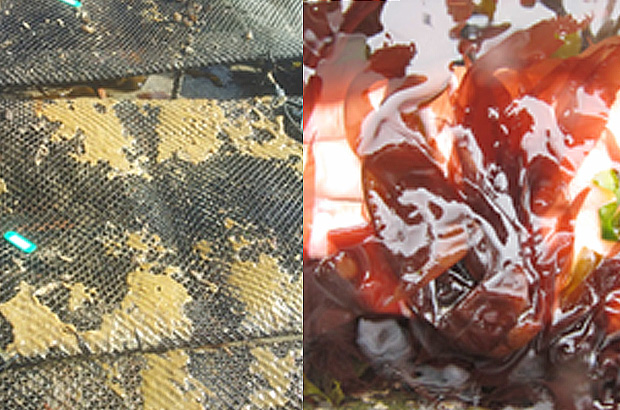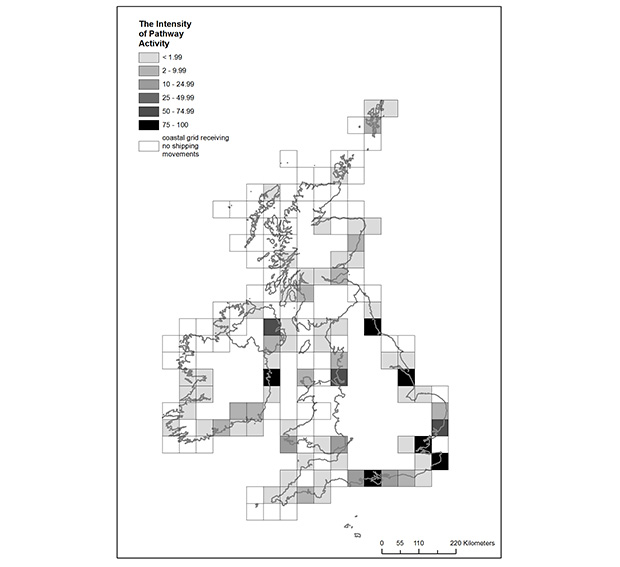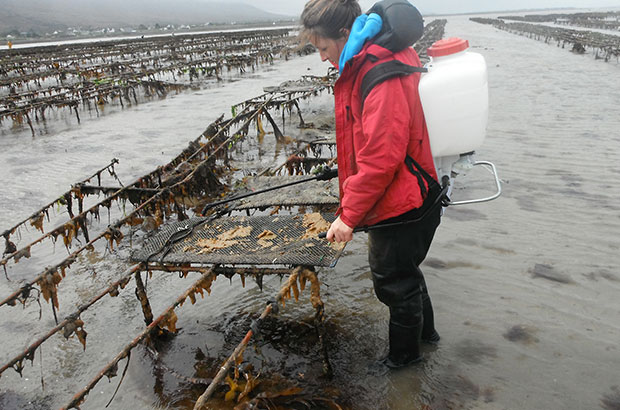Marine non-indigenous species (NIS) impact wild and farmed shellfish, as they are species which have been introduced into locations outside their natural range.
Marine NIS can have severe impacts on marine biodiversity, for example competing with native species and changing ecosystems and habitats. NIS may also interfere with aquaculture processes, lowering yields and increasing labour and management requirements. So they threaten the industry.
There are many marine NIS which pose a threat to wild and farmed shellfish around the coast of Great Britain (GB) and Ireland. Two examples are:

- The Carpet Sea Squirt, Didemnum vexillum. Native to Japan, this species is of concern as it overgrows native plants and animals. It also interferes with aquaculture production, for example enveloping shellfish and fouling equipment.
- Devil’s Tongue Weed, Grateloupia turuturu. Also native to Japan, China and Korea. This species of algae has large broad blades which have the potential to deprive native species of light and space.
The need to better understand marine NIS and develop tools which can be used to manage and eradicate them is clear. So we setup a multi-organisation project - called the Marine Pathways Project - to tackle the issue of marine NIS. The goal of the project is to:
protect marine biodiversity in Great Britain and Ireland by managing key pathways by which marine invasive non-native species are introduced and spread.
To achieve this, the project addresses 4 areas:
1. Monitoring
To manage and control NIS, an understanding of the current quantities and locations of NIS is required. Also early detection of NIS introductions is crucial. Being able to respond rapidly to NIS introductions can minimise the spread and impact. Monitoring and surveillance of NIS is therefore key to NIS control and management.
This project has a number of monitoring elements. These include research conducted with coastal-based industries. One example are Welsh oyster farmers, marina operators and lobster and crab fishermen helping to identify the optimum ways to detect new marine invasions. Methods for detecting NIS inshore and offshore are also being investigated by project partners in Scotland. Also we’re investigating using offshore monitoring buoys as early warning systems of NIS introduction.
2. Introduction pathway assessments

There are a number of pathways by which marine NIS can be introduced into and spread within marine waters. The key pathways are:
- commercial shipping
- recreational boating
- aquaculture stock movements
- natural dispersal
The project assessed the strength of introduction pathway activities. This assessment helps identify coastal areas where NIS may be more likely to be introduced. Which then helps management and monitoring by preventing and quickly detecting introductions.
An example of this in action was using shipping tracking data to show commercial shipping pathway activity around the coast of GB and Ireland. This data was translated into a heat map. This helps visualise areas of coast with high shipping activity, which means an increased risk of NIS introduction.
3. Biosecurity guidelines and raising awareness
Identifying introduction and spread pathways has highlighted key sectors who impact NIS risk. These sectors are important. They can be part of the solution by managing NIS species using best practice biosecurity.
To do this the project is raising awareness of NIS across these industries through training and guidance. They can then incorporate simple and effective biosecurity advice to improve biosecurity measures and biosecurity planning.
4. Control and eradicating

We’re also researching potential control and eradication approaches for NIS. Currently we’re running a series of experiments to investigate methods of control and eradication of Carpet Sea Squirt (D. vexillumn) off the west coast of Ireland.
For further information on the marine pathways project please contact me, or visit the Marine Pathways Project.
For updates please sign up to email alerts from this blog, or you can follow us on Twitter @CefasGovUK.